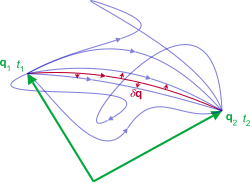
Back Principi d'Hamilton Catalan Hamiltonův variační princip Czech Hamiltons princip Danish Hamiltonsches Prinzip German Αρχή του Χάμιλτον Greek Hamiltona principo Esperanto اصل همیلتون Persian हैमिल्टन का सिद्धान्त Hindi Principio variazionale di Hamilton Italian Ең аз мәжбүрлеу принципі Kazakh

| Part of a series on |
| Classical mechanics |
|---|
In physics, Hamilton's principle is William Rowan Hamilton's formulation of the principle of stationary action. It states that the dynamics of a physical system are determined by a variational problem for a functional based on a single function, the Lagrangian, which may contain all physical information concerning the system and the forces acting on it. The variational problem is equivalent to and allows for the derivation of the differential equations of motion of the physical system. Although formulated originally for classical mechanics, Hamilton's principle also applies to classical fields such as the electromagnetic and gravitational fields, and plays an important role in quantum mechanics, quantum field theory and criticality theories.
- ^ R. Penrose (2007). The Road to Reality. Vintage books. p. 474. ISBN 978-0-679-77631-4.
© MMXXIII Rich X Search. We shall prevail. All rights reserved. Rich X Search
